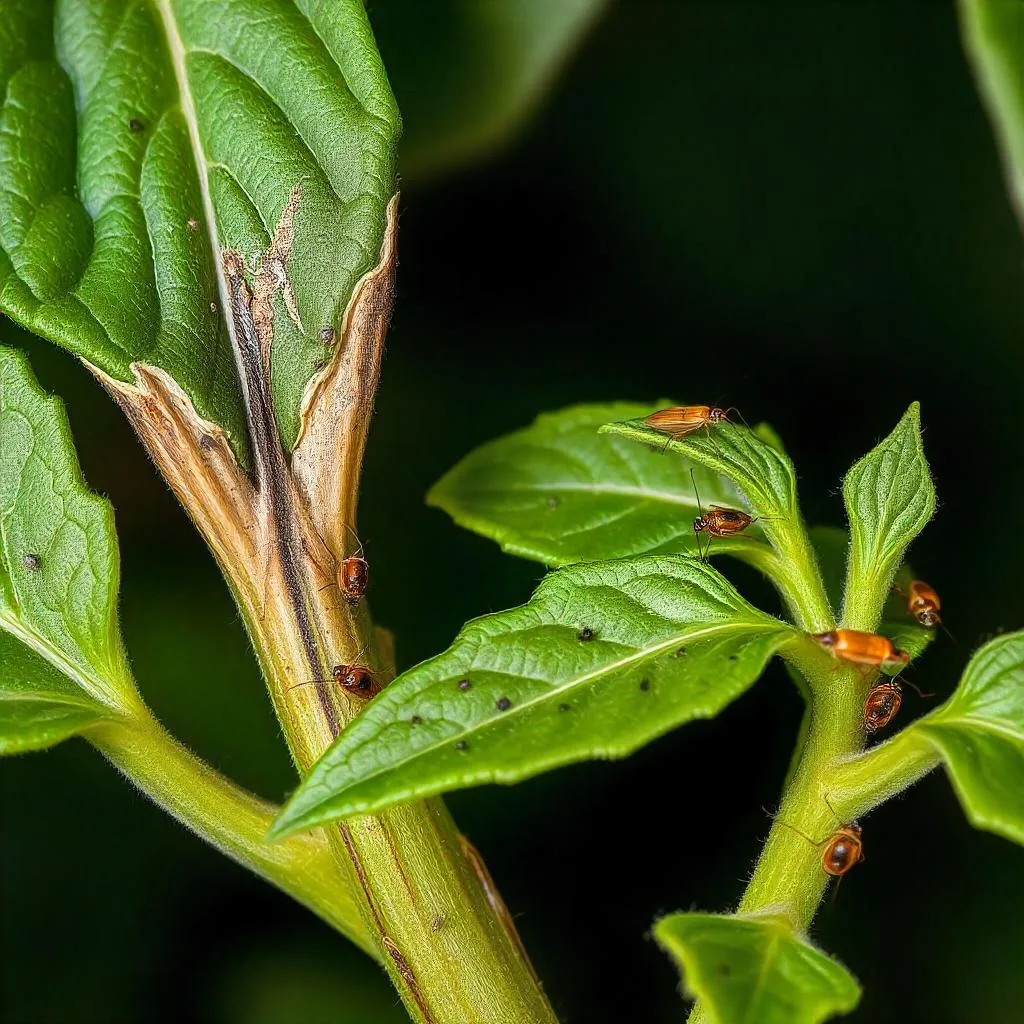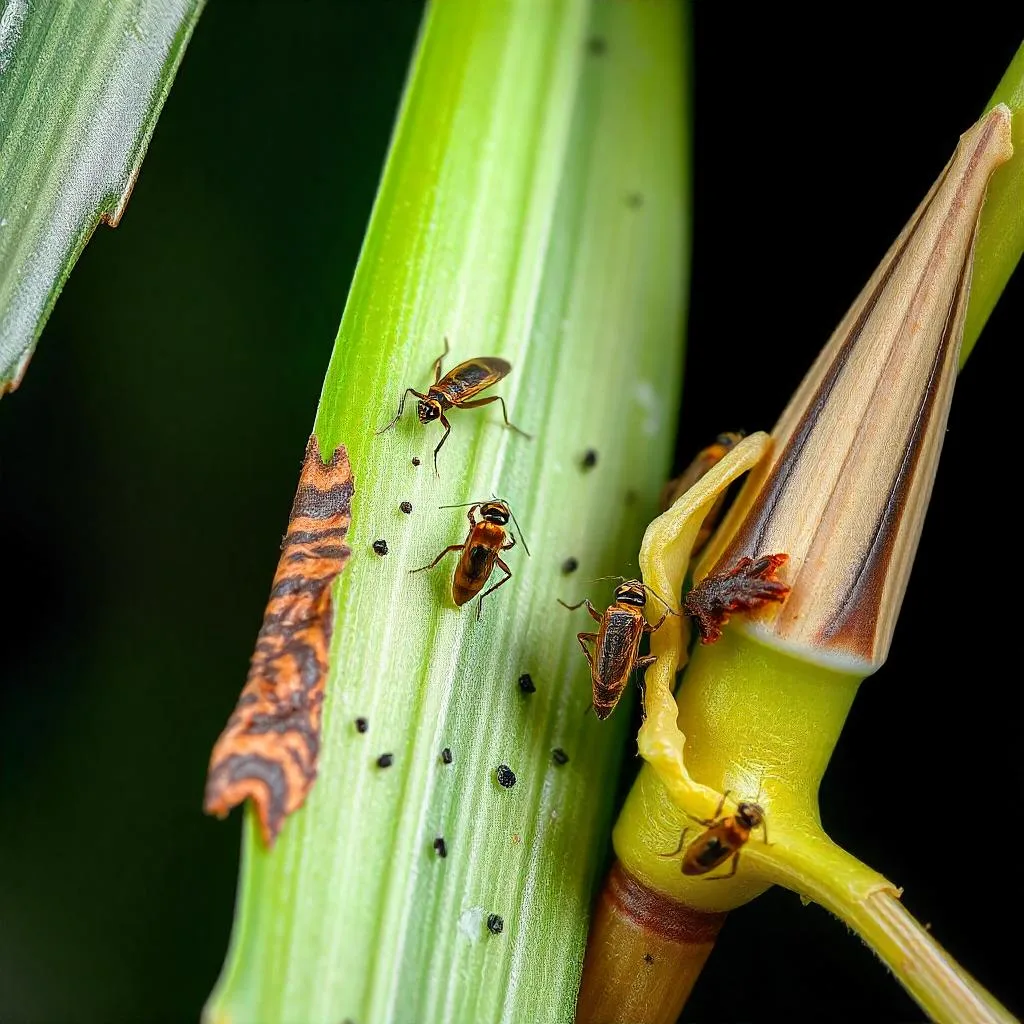To get rid of Thrips, start by isolating the affected plants to prevent spread. Use insecticidal soap, neem oil, or a strong water spray to dislodge and kill these pests. Regularly cleaning leaves and checking for early signs can help keep your plants thriving and thrip-free.
What Are Thrips?
Thrips are tiny, winged insects that feed on the sap of plants. They are often difficult to spot due to their small size, but the damage they cause can be extensive. Thrips use their piercing mouthparts to suck out plant juices, which leads to discolored, scarred, or deformed leaves. Left unchecked, a thrips infestation can weaken your plants, causing stunted growth or even death.
Understanding Thrips: An Overview
Thrips are typically less than 1/20th of an inch long, making them hard to see with the naked eye. They range in color from yellow to black, and some species have wings, which allow them to move easily between plants. Thrips thrive in warm, dry conditions, which makes houseplants, especially those kept indoors during winter, particularly vulnerable.
Common Signs of Thrips Infestation
Detecting a thrips infestation early is key to minimizing damage. Some of the most common signs of thrips on houseplants include:
- Silvery or bronze streaks on leaves: This is often the first sign, as thrips suck the sap from leaves, leaving behind a silvery sheen.
- Deformed or curled leaves: Thrips feeding can cause leaves to grow irregularly or curl up.
- Black specks on leaves: These are thrips’ excrement, which may appear as tiny black dots on the plant.
- Visible thrips: If you look closely, you may see tiny insects moving quickly on the underside of leaves or within flowers.
How to Get Rid of Thrips on Houseplants
Once you’ve identified an infestation, it’s important to act quickly to prevent further damage. Here are several methods to get rid of thrips on houseplants:
Prune Affected Areas
One of the simplest ways to reduce the thrips population is to prune any heavily infested or damaged areas of the plant. Carefully remove any leaves or stems showing significant signs of thrips damage. Be sure to dispose of the pruned materials properly—away from your other plants—to prevent further infestations.
Rinse with Water
A strong stream of water can dislodge thrips from your plants. Take your plant to a sink or shower and thoroughly rinse it, paying special attention to the undersides of the leaves, where thrips like to hide. Repeat this process every few days to ensure you’re removing newly hatched thrips as well.
Apply Insecticidal Soap or Neem Oil
Insecticidal soaps and neem oil are two of the most effective treatments for thrips. Both products work by suffocating the insects without harming your plants. Neem oil also has the added benefit of disrupting the life cycle of thrips, preventing them from reproducing.
- How to use: Mix the insecticidal soap or neem oil according to the package instructions. Spray the solution onto the affected plant, making sure to cover both the tops and undersides of the leaves. Reapply every 5-7 days until the infestation is under control.
Use Diatomaceous Earth for Long-Term Control
Diatomaceous earth (DE) is a natural, non-toxic powder that can help control thrips over time. It works by dehydrating the insects when they come into contact with it. Sprinkle a fine layer of food-grade DE around the base of your plants and on the surface of the soil.
Introduce Beneficial Predators
Natural predators like ladybugs, lacewings, and predatory mites can help keep thrips populations in check. These beneficial insects feed on thrips and their larvae, reducing their numbers naturally. While this method is more commonly used in outdoor or greenhouse settings, it can be effective indoors if you’re dealing with a major infestation.
Use Sticky Traps for Early Detection
Sticky traps are an excellent way to monitor for thrips and catch flying adults before they can reproduce. Place yellow or blue sticky traps around your plants to capture thrips and help you track the severity of the infestation. This method is especially useful for early detection.
Avoid Harsh Chemical Insecticides
While it may be tempting to resort to chemical insecticides, these are often unnecessary and can harm beneficial insects or even your plants. Thrips can also develop resistance to chemical treatments, making them less effective over time. Stick to natural or organic treatments whenever possible.

How to Prevent Thrips on Houseplants
Preventing thrips from infesting your houseplants in the first place is much easier than dealing with an active infestation. Here are some tips to help you avoid thrips problems:
Regularly Inspect New Plants
Always inspect new plants thoroughly before bringing them into your home. Thrips can easily hitch a ride on new plants, spreading quickly to your existing collection. Quarantine any new plants for a couple of weeks to ensure they are pest-free.
Keep Plants Healthy with Proper Care
Healthy plants are better equipped to withstand pest infestations. Make sure your houseplants are receiving the right amount of light, water, and nutrients. Stressed or weakened plants are more susceptible to thrips and other pests.
Maintain a Clean Growing Environment
Keeping your plant area clean can go a long way in preventing thrips and other pests. Regularly wipe down surfaces, remove dead leaves, and clean plant pots. Thrips are attracted to dust and debris, so maintaining a clean environment reduces their breeding grounds.
Choose Thrips-Resistant Plant Varieties
Some plants are more resistant to thrips than others. If you’re struggling with repeated infestations, consider growing houseplants that are less prone to pests. Succulents, ferns, and certain types of orchids tend to be more resistant to thrips.
Avoid Overfertilization
Overfertilizing your plants can lead to excessive soft growth, which is particularly attractive to thrips. Stick to a balanced fertilization schedule and avoid feeding your plants too frequently.
Repel Thrips with Companion Plants
Certain plants, like basil, marigold, and garlic, have natural properties that can repel thrips. Consider planting these near your houseplants or placing pots of these plants nearby to help deter thrips.
Recognizing Thrips on Houseplants
Recognizing thrips early can help you take action before the infestation gets out of control. Here are some key signs to look for:
Spotting Thrips Movement and Damage
Thrips are small and move quickly, so you may need a magnifying glass to see them clearly. Look for tiny, slender insects on the undersides of leaves or in flower buds. Damage often appears as silvery streaks or patches on the leaves.
Check for Discoloration and Deformed Leaves
Thrips feeding can cause leaves to become discolored, with pale or silvery patches. You may also notice curling, distortion, or stunted growth.
Use Sticky Traps to Monitor Infestations
Sticky traps not only help control adult thrips but also serve as an effective monitoring tool. Place traps near your plants and check them regularly for signs of thrips. Early detection is key to preventing a full-blown infestation.
Thrips Damage on Houseplants
Thrips can damage houseplants in several ways, from cosmetic damage to more serious health issues. Here are some of the most common types of damage:
Identifying Leaf Scarring and Silvery Marks
As mentioned earlier, thrips feed by sucking the sap from plant tissues, which leaves behind silvery or bronze streaks. These scars are often the first visible sign of a thrips infestation.
Wilting and Premature Leaf Drop
In severe cases, thrips can cause your plant to wilt or drop its leaves prematurely. This happens because the insects are draining essential nutrients from the plant, weakening it over time. If left untreated, thrips can eventually kill the plant.

Life Cycle of Thrips
Understanding the life cycle of thrips can help you better target your treatments. Thrips go through several stages of development, from eggs to larvae to adults.
Understanding the Reproduction and Stages
Thrips lay their eggs inside plant tissue, where they are protected from most treatments. The eggs hatch into larvae, which feed on the plant before molting into adults. The adult thrips then continue to feed, mate, and lay more eggs, repeating the cycle.
How the Thrips Life Cycle Affects Treatment Timing
Because thrips lay their eggs in plant tissue, it can be difficult to eliminate them completely with just one treatment. You’ll need to treat your plants multiple times to catch each stage of the thrips’ life cycle. Regular monitoring and reapplication of insecticidal soap or neem oil every few days is essential for effective control.
Thrips-Resistant Houseplants
If you’ve struggled with repeated thrips infestations, you might want to consider growing houseplants that are naturally more resistant to pests. Some houseplants are less likely to attract thrips, which can help you avoid future problems.
- Succulents: Thrips tend to avoid thick, fleshy plants like succulents.
- Ferns: Ferns are generally less susceptible to thrips, making them a good option for pest-prone areas.
- Orchids: Some types of orchids, particularly those with thicker leaves, can resist thrips infestations more effectively than other plants.
Conclusion
Thrips can be a frustrating pest for houseplant enthusiasts, but with the right strategies, you can eliminate them and prevent future infestations. By regularly inspecting your plants, maintaining a clean growing environment, and using natural treatments like neem oil, you can keep your houseplants healthy and thrips-free. Remember, early detection and consistent treatment are key to successfully getting rid of thrips on houseplants.
FAQ
The best approach is to use a combination of methods, including pruning affected areas, rinsing the plant, applying neem oil or insecticidal soap, and using sticky traps to monitor for new thrips.
Apply neem oil every 5-7 days until the infestation is under control. Consistent application is important because neem oil disrupts the thrips’ life cycle.
Yes, thrips can spread quickly from plant to plant. This is why quarantine and regular inspection of new plants are essential to prevent infestations.
Houseplants can become infested with thrips if they are exposed to other infested plants, if the growing environment is dry and warm, or if they are stressed due to improper care.
Yes, companion plants like basil, marigolds, and garlic can help repel thrips naturally. Beneficial insects such as ladybugs and lacewings can also help control thrips populations.

